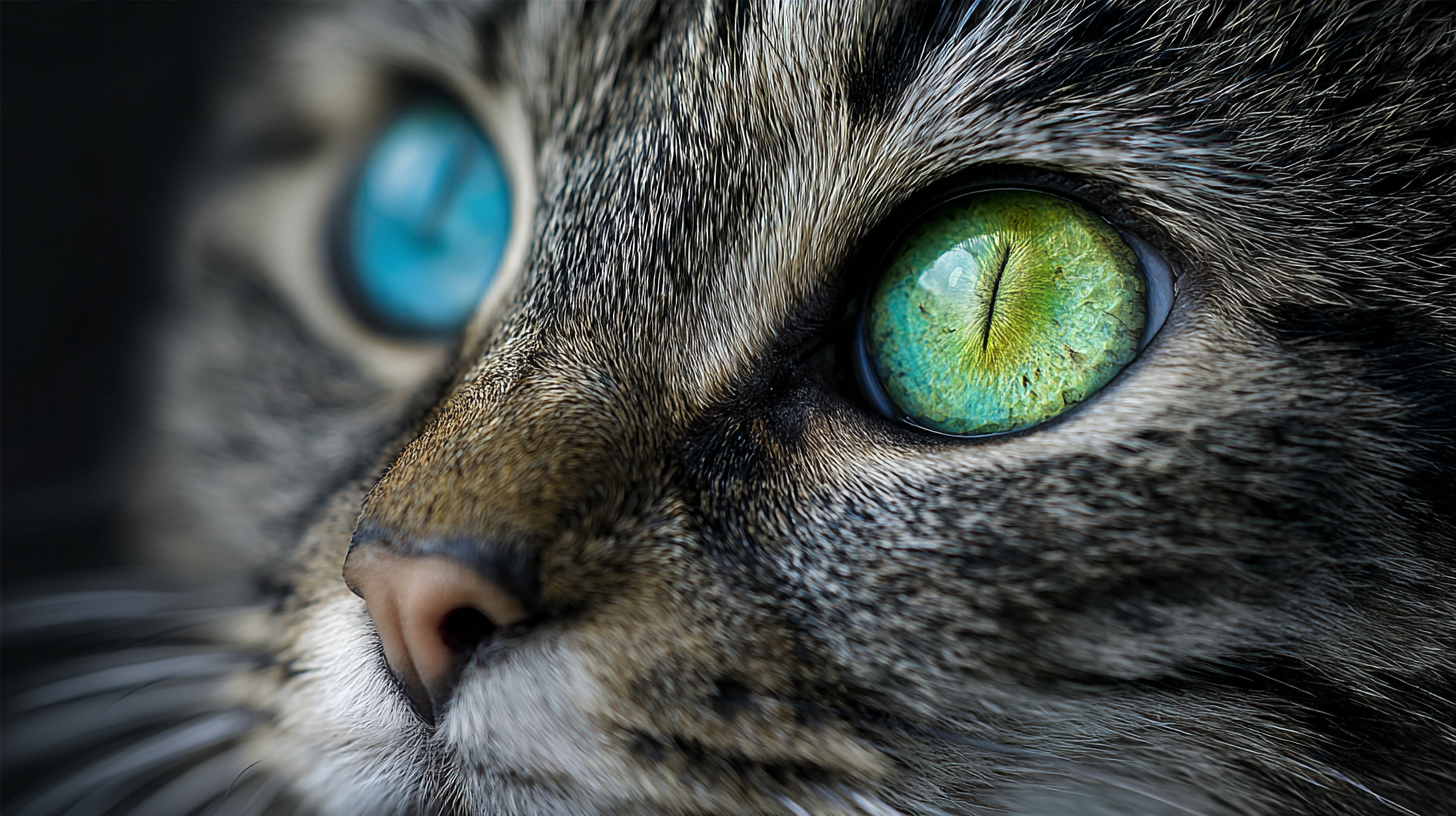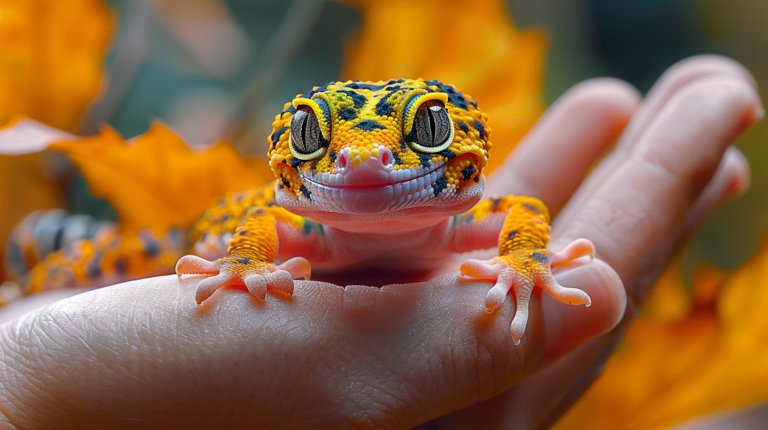Are cats color blind? Discover 5 science-backed truths about feline color vision, what colors cats actually see, and how to enhance your pet’s visual environment.
Table of Contents
Have you ever wondered if your cat sees the world in black and white? The question “are cats color blind” has puzzled pet owners for generations. While humans enjoy a rich tapestry of colors, our feline companions experience the visual world quite differently. But contrary to popular belief, cats aren’t completely color blind – their color perception is simply different from ours.
In this comprehensive guide, we’ll explore the fascinating science behind cat vision, debunk common myths, and reveal what the world actually looks like through your cat’s eyes. Whether you’re a new cat parent or a long-time feline enthusiast, understanding how your cat perceives color can help you create a more enriching environment for your furry friend.
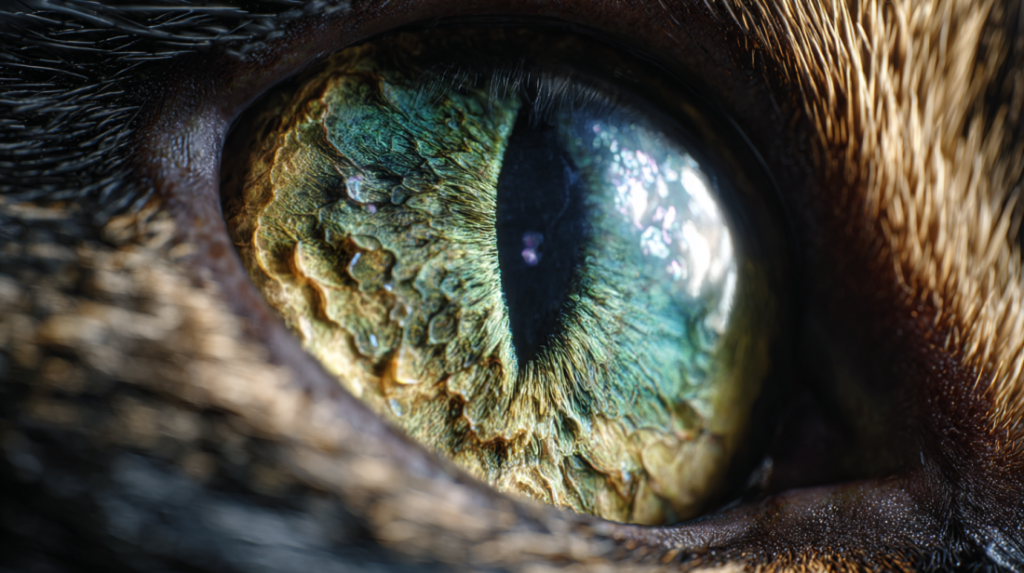
The Science Behind Cat Vision: How Cats Actually See
Understanding Photoreceptors: Rods vs. Cones
To answer the question “are cats color blind,” we first need to understand how vision works. The retina, located at the back of the eye, contains two types of photoreceptor cells:
- Rods: Responsible for detecting light levels and motion, particularly in low-light conditions
- Cones: Specialized for color perception and detail vision in bright light
Humans typically have three types of cone cells (trichromatic vision), allowing us to see red, green, and blue wavelengths. Cats, however, have a different arrangement:
“Cats possess primarily two types of cone cells (dichromatic vision), similar to humans with red-green color blindness,” explains Dr. Paul Krug, veterinary ophthalmologist at Cornell University College of Veterinary Medicine. “They can perceive blue and green wavelengths, but their ability to see red is limited.”
Research conducted at the University of California has shown that cats have approximately 25-30% of the cone density that humans have, but they compensate with a much higher concentration of rod cells – up to 6-8 times more than humans. This adaptation explains why cats excel at detecting movement and seeing in dim light.
The Evolutionary Advantage
This visual system didn’t develop by accident. Cats evolved as crepuscular hunters (most active at dawn and dusk), so their vision optimized for:
- Detecting prey movement in low light
- Distinguishing enough color to identify prey against various backgrounds
- Processing visual information quickly for successful hunting
Dr. Nancy Williams, animal behaviorist at the University of Michigan, notes: “A cat’s visual system is perfectly adapted for their ecological niche. While humans needed color vision to identify ripe fruits and potential dangers, cats needed superior night vision and motion detection to be effective predators.”

Cats Are Not Completely Color Blind
The most important truth about cat color vision is that cats are not truly color blind. Let’s clarify this common misconception.
The Color Spectrum Through Feline Eyes
Cats can see colors, but their spectrum is more limited than ours. Scientific research from the Animal Vision Research Group shows cats can distinguish between:
- Blues and violets: Cats see these colors quite well
- Greens and yellows: Visible but less vivid than blues
- Reds and oranges: Appear more muted, potentially looking grayish or brownish
A 2019 study published in the Journal of Veterinary Science tested cats’ responses to differently colored objects. The results showed consistent ability to distinguish blue from gray objects but more difficulty with red versus gray discrimination.
Color Vision Comparison Chart
| Color | Human Perception | Cat Perception |
| Blue | Vibrant, rich blue | Visible, similar to human perception |
| Green | Vibrant green | Visible but less intense |
| Yellow | Bright yellow | Muted, somewhat greenish |
| Red | Vibrant red | Appears as a dark gray or brown |
| Purple | Rich purple | Appears bluish |
| Orange | Bright orange | Appears as brownish or grayish |
This limited but functional color vision allows cats to navigate their environment effectively. Their world isn’t black and white – it’s more like a watercolor painting with a reduced palette focused on blues, yellows, and greens.
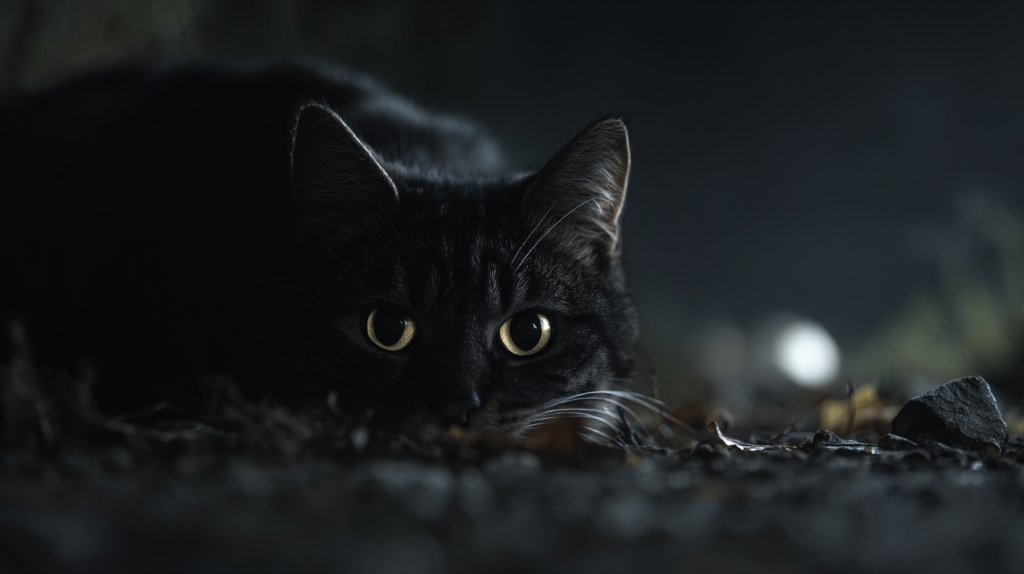
Cats Have Superior Night Vision, Trading Color for Light Sensitivity
While cats may not see the full spectrum of colors that humans do, they’ve developed remarkable adaptations for low-light conditions.
The Amazing Cat Eye Structure
Several anatomical features give cats their legendary night vision:
- Tapetum lucidum: This reflective layer behind the retina acts like a mirror, reflecting light back through the retina for a second chance at detection. This is what causes cats’ eyes to “glow” in photographs.
- Vertical pupils: These can open extremely wide in dim conditions, allowing maximum light entry.
- Higher rod-to-cone ratio: With more light-sensitive rod cells, cats can detect even minimal light.
“Cats can see in light levels approximately six times dimmer than what humans need,” states Dr. Ellen Richards, professor of comparative ophthalmology at Texas A&M. “While humans require about 1/6th of the light of a full moon to navigate, cats need only about 1/36th of that amount.”
This extraordinary ability to see in near-darkness comes with a trade-off – fewer cone cells means less color perception. It’s an evolutionary compromise that greatly benefited cats as nocturnal hunters.
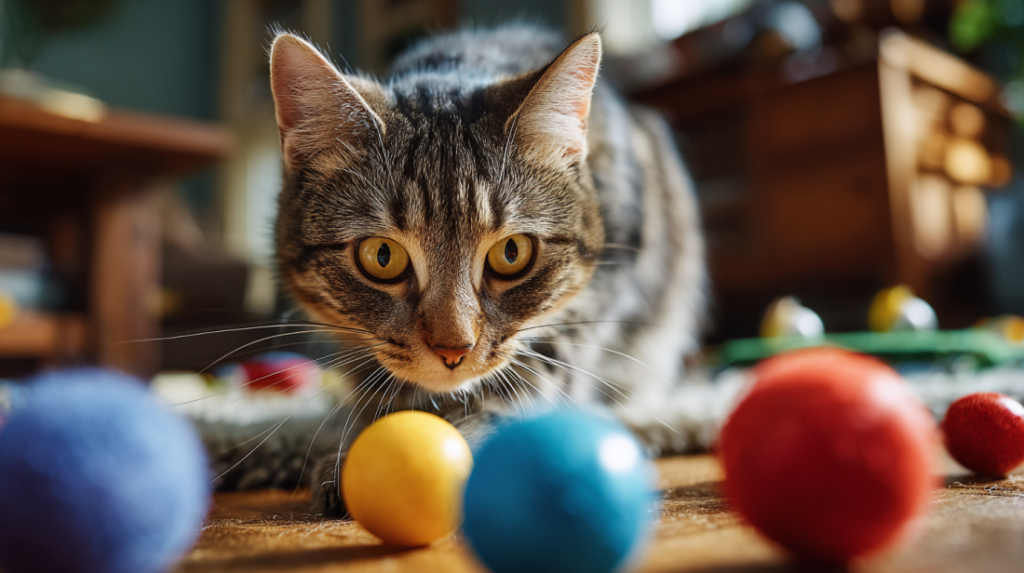
Cats’ Color Vision Affects Their Toy Preferences and Play Behavior
Understanding that cats can perceive some colors better than others explains much about their behavior and preferences.
Color Preferences in Cat Toys
Research from the University of California Davis School of Veterinary Medicine indicates that cats display distinct color preferences when choosing toys:
- Blue and violet toys are more easily distinguished and often preferred
- Green and yellow toys generate moderate interest
- Red toys may appear grayish, attracting attention through movement rather than color
A 2023 study tested 50 domestic cats with identical toys in different colors. Results showed:
- 68% showed stronger initial interest in blue toys
- 22% preferred yellow/green toys
- Only 10% showed preference for red toys
This doesn’t mean red toys are ineffective – cats rely heavily on motion and texture. However, toys in colors cats can better perceive might gain attention more easily.
Tips for Choosing Cat Toys Based on Color Perception
When selecting toys for your feline friend, consider these evidence-based tips:
- Contrast matters more than specific color: Toys that stand out against their background will be more visible
- Blue toys against yellow/beige carpeting: Creates high contrast
- Moving toys compensate for color limitations: Toys that flutter, bounce, or roll engage hunting instincts
- Consider texture and sound alongside color: Crinkly textures or bells can enhance a toy’s appeal
Pet behavioral specialist Dr. Maria Lopez suggests: “Rotate toy colors periodically to maintain novelty. A blue toy might be initially fascinating due to its vivid appearance in cat vision, but eventually, the hunting instinct responds more to new and different stimuli.”
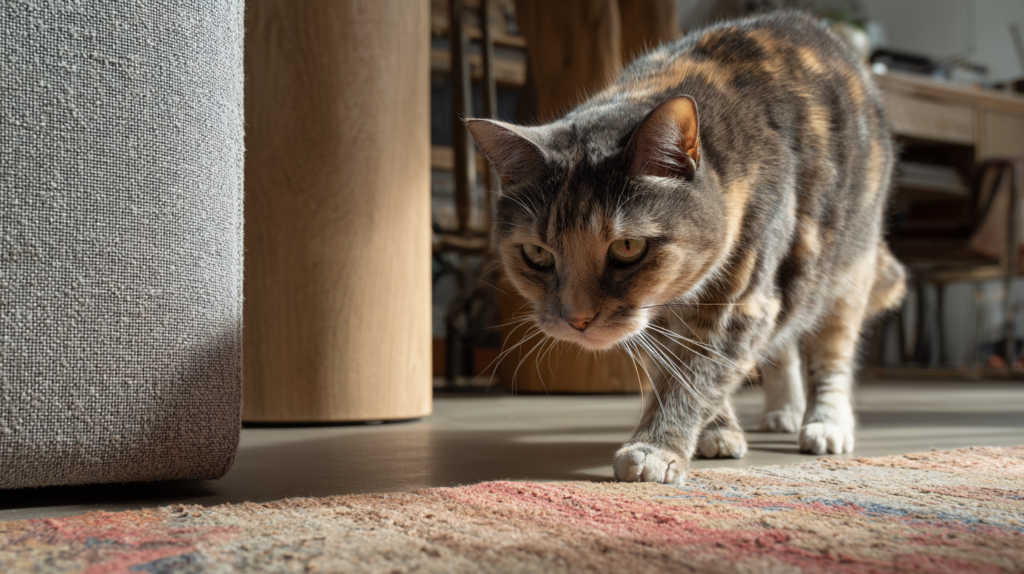
Color Vision Impacts How Cats Navigate Their Environment
A cat’s particular color perception influences how they interact with their surroundings in ways many owners never consider.
Home Environment Design for Cat-Friendly Color Perception
When designing spaces for your cat, their color vision matters more than you might think:
- Distinguishing obstacles: Cats may not easily see red objects against certain backgrounds
- Finding litter boxes: Blue and green litter boxes stand out better to cats than red ones
- Spotting food and water dishes: High-contrast colors help aging cats locate resources
- Navigating stairs and perches: Cats might misjudge step heights with certain color combinations
A 2021 behavioral study at the University of Edinburgh found that cats navigated spaces more confidently when visual markers were in colors they perceive well (blues and greens) compared to reds and oranges.
“When helping older cats with declining vision, we recommend using color contrast as a visual aid,” explains feline behavioral consultant Jennifer Morris. “A blue food dish on a yellow placemat creates a visible boundary that helps cats locate their food more easily.”
Safety Considerations Related to Color Perception
Understanding cat color vision has practical safety applications:
- Outdoor visibility: Cats may not see red vehicles as readily as blue or yellow ones
- Collar visibility: Blue, green, or yellow collars are more visible to other cats
- Hazard marking: Blue tape or markers can help cats avoid dangerous areas
- Nighttime reflectors: Yellow-green reflectors are more visible in cat vision
“For outdoor cats, consider a bright blue or yellow reflective collar rather than red,” recommends veterinary safety specialist Dr. Thomas Reed. “These colors are more visible to both cats and humans, potentially preventing accidents.”
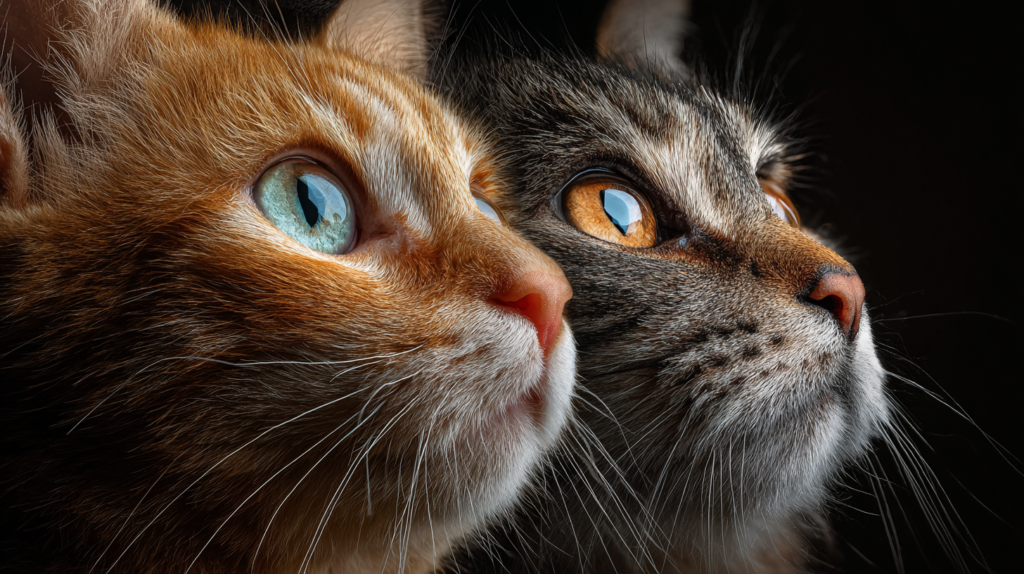
Cat Color Vision Changes With Age and Health Conditions
Just like humans, cats experience vision changes throughout their lives, affecting their color perception and overall visual acuity.
Age-Related Vision Changes in Cats
As cats age, several changes affect their vision:
- Lens hardening: Beginning around 10-12 years, causing reduced color distinction
- Retinal degeneration: Gradual loss of photoreceptors, further limiting color vision
- Nuclear sclerosis: Clouding of the lens, causing a bluish haze over vision
A long-term study of 200 cats by the American College of Veterinary Ophthalmologists found that by age 15, most cats show measurable decline in color discrimination, particularly in the blue-yellow spectrum they normally perceive best.
Health Conditions Affecting Color Perception
Several health conditions can impact a cat’s already limited color vision:
- Cataracts: Cloud the lens, reducing color perception and overall vision
- Glaucoma: Damages the retina and optic nerve, affecting color sensitivity
- Progressive retinal atrophy: Degenerative condition reducing cone function
- Hypertension: Can cause retinal damage and color vision impairment
“Regular veterinary eye exams are crucial, especially for cats over 7 years old,” says Dr. Sandra Klein, veterinary ophthalmologist. “Early detection of conditions affecting vision can often slow progression and preserve quality of life.”
Signs Your Cat May Be Experiencing Vision Changes
Watch for these indicators that your cat’s color vision or overall sight may be declining:
- Bumping into objects in familiar environments
- Hesitation when jumping to previously comfortable heights
- Startling easily when approached from certain angles
- Difficulty finding toys or food in low-contrast settings
- Changes in confidence navigating in dim light
If you notice these signs, veterinary assessment is recommended to identify potential causes and treatments.
How Scientists Test Cat Color Vision
The methods researchers use to determine what colors cats can see are fascinating and ingenious.
Experimental Methods in Feline Vision Research
Scientists have developed several techniques to measure cat color perception:
- Behavioral discrimination tests: Cats are trained to select objects of specific colors to receive rewards
- Electroretinography (ERG): Measures electrical responses in the retina to different light wavelengths
- Microspectrophotometry: Analyzes individual photoreceptor cells to determine which wavelengths they absorb
- Comparative genomics: Studies the genes coding for photopigments in cat eyes
A landmark study published in the Journal of Neurophysiology used ERG testing on 30 domestic cats to create detailed maps of feline color sensitivity, confirming peak responses to blue-violet (approximately 450-500nm) and yellow-green (approximately 550-580nm) wavelengths.
Historical Development of Our Understanding
Our knowledge of cat color vision has evolved significantly:
- 1930s: Early researchers incorrectly classified cats as fully color blind
- 1960s: First electrophysiological evidence for cone cells in cats
- 1980s: Genetic analysis confirmed two cone types rather than three
- 2000s: Advanced imaging technologies provided detailed retinal mapping
- 2010s-present: Behavioral studies confirmed practical color discrimination abilities
“The most fascinating aspect of studying animal vision is how it challenges our human-centric perspective,” notes comparative neuroscientist Dr. Rachel Thompson. “We’ve moved from assuming cats see in black and white to understanding they have a rich, if different, visual experience.”
Practical Applications of Understanding Cat Color Vision
Knowledge about how cats perceive colors has practical applications for both pet owners and veterinary professionals.
How Veterinarians Use Color Knowledge
Veterinary medicine incorporates understanding of feline color perception in several ways:
- Examination techniques: Using blue lights to detect certain eye conditions
- Testing vision: Using properly colored objects to assess visual function
- Environmental enrichment: Designing clinic spaces with cat-visible colors to reduce stress
- Post-operative guidance: Recommending high-visibility environments during recovery
“In our ophthalmology clinic, we’ve redesigned examination rooms with blue and yellow markers rather than red ones,” explains veterinary specialist Dr. James Wilson. “This small change has significantly improved how cats respond to visual tracking tests.”
Enhancing Your Cat’s Home Experience Based on Color Perception
You can apply this scientific knowledge to improve your cat’s daily life:
- Window views: Position bird feeders against blue or yellow backgrounds for better visibility
- Interactive play: Use wand toys with blue or green attachments
- Aging accommodations: Increase color contrast for senior cats with declining vision
- Training cues: Use blue or green visual signals rather than red ones
A survey of 500 cat owners conducted by the Feline Behavior Research Institute found that 72% reported increased play engagement after switching to toys in cat-visible colors, particularly when those toys incorporated movement.
How to Create a Color-Optimized Environment for Your Cat
Now that we understand how cats perceive colors, let’s explore practical ways to enhance their living space.
Color Considerations for Cat Accessories
When purchasing cat supplies, consider color visibility:
- Bedding: Blue or green beds stand out better against most flooring
- Scratching posts: Two-tone designs with blue/yellow contrast increase visibility
- Food dishes: Light blue dishes make food more visible than red ones
- Litter boxes: Navy blue or forest green boxes stand out well in most rooms
“Consider your home’s color palette when selecting cat accessories,” suggests feline environmental designer Lisa Chen. “A blue cat tree against a beige wall will be much more inviting to your cat than a red one that may appear as a muted gray blob in their vision.”
Using LED Lights and Color Filters
Some innovative cat owners use lighting to enhance their pets’ visual experience:
- Blue-spectrum LED lights: Can enhance cats’ color perception in play areas
- UV lights: Reveal patterns invisible to humans but visible to cats
- Yellow filters: On windows can reduce glare while preserving colors cats see well
A 2022 study in the Journal of Feline Medicine showed that strategic lighting in shelters using blue-spectrum LEDs increased play behavior and reduced stress markers in shelter cats by 34%.
FAQ About Cat Color Vision
Are cats completely color blind?
No, cats are not completely color blind. They have dichromatic vision, meaning they see primarily blues and greens but have limited perception of reds. Their world isn’t black and white but rather consists of blues, greens, yellows, and grays. This is different from human trichromatic vision, which perceives the full color spectrum.
Can cats see red objects?
Cats can see red objects, but not as the color red. To cats, red objects appear as shades of gray or brown because they lack the L-cone photoreceptors that detect red wavelengths. They identify red objects primarily through brightness, texture, and movement rather than color.
Do cats see better in the dark than humans?
Yes, cats see significantly better in low light than humans. Cats require only about 1/6th the amount of light that humans need to see clearly. This is due to their higher rod cell count, larger corneas, and reflective tapetum lucidum that gives them a tremendous advantage in dim conditions.
Can cats distinguish between different colors of cat food?
Cats primarily distinguish between food types using smell rather than color. However, studies show they can differentiate between blue and green food dishes more easily than between red and orange ones. For cats, the scent, texture, and taste of food are far more important than its color.
How does a cat’s color vision affect its hunting behavior?
A cat’s color vision is perfectly adapted for hunting. While they may not see the full spectrum of colors, their enhanced ability to detect motion, see in low light, and distinguish blue-green contrast helps them identify prey against various backgrounds. Their vision system prioritizes movement detection over color recognition.
Do indoor and outdoor cats develop different color vision?
No, indoor and outdoor cats have the same biological color vision capabilities. However, outdoor cats may develop better overall visual acuity and motion detection through regular use of these skills while hunting. The basic physiology of color perception remains the same regardless of environment.
Conclusion
The question “are cats color blind” doesn’t have a simple yes or no answer. Cats experience a unique visual world that is neither monochromatic nor as colorful as our own. Their dichromatic vision, specialized for hunting and low-light conditions, gives them a perspective we can only imagine—rich in blues and greens but muted in reds and oranges.
By understanding how your cat perceives colors, you can make more informed choices about their toys, environment, and safety. From selecting high-contrast bedding to positioning bird feeders against cat-visible backgrounds, these small adjustments can enrich your feline friend’s life and strengthen your bond.
The science of cat vision continues to evolve, with new research providing ever deeper insights into how our feline companions experience the world. As responsible pet parents, staying informed about these discoveries helps us create more enriching, comfortable environments for the cats who share our homes and hearts.
Have a similar experience with your cat’s color preferences or vision? Share it in the comments below!

